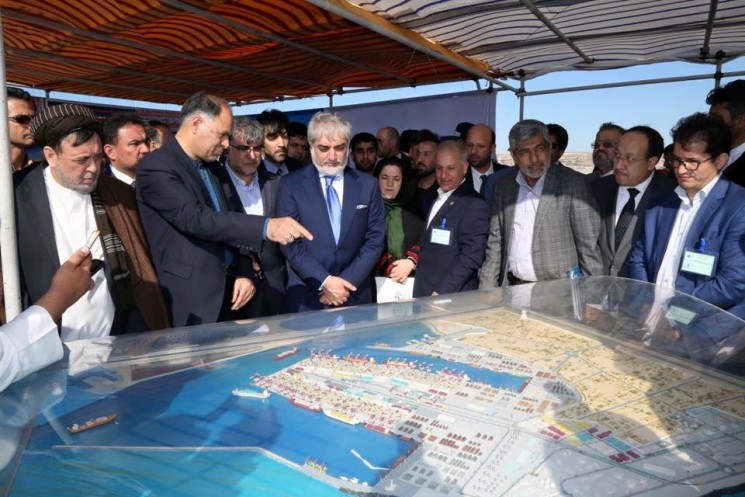TEHRAN – “Mistreatment of Afghan businesspeople by Pakistanis has made them complain.” This story has been covered by Afghan media time and time again, but they have no choice. Afghanistan is a landlocked country with no access to free waters and Karachi port in Pakistan is the sole route for Afghans through which they can engage in trade with the rest of the world.
Therefore, Afghan officials have reached the conclusion that in cooperation with India, they must go for Iran’s south-eastern Chabahar port, which can offer a good substitute for Karachi port. This issue was one of the main reasons behind a three-day trip to Iran early January by Afghanistan’s chief executive officer, Abdullah Abdullah.
A look at the map will tell the whole story. Afghanistan is a country locked in land on all four sides and in order to do trade, it has to get access to free waters. During past decades, Karachi port in Pakistan was considered the best option for this purpose, so that half of Afghanistan’s trade was conducted through Pakistan route.
However, relations between Pakistan and Afghanistan have been always affected by Afghanistan’s need of Pakistan. As a result, by understanding its geographical position and the degree of Afghanistan’s need of this transit route, Islamabad has more than once used this issue as a tool to mount political pressure on Afghanistan, and has tried to impose its political will on Afghan statesmen through pressures on trade sector.
In addition to the above-mentioned issues, the high cost of trade through Pakistan is another factor that has been nagging Afghans. According to Iran’s IRNA news agency, the customs tariff levied for import of goods to Afghanistan via Pakistan is high and, for example, for a truck loaded with a cargo of 40 tons of fruits or other foodstuff, it stands at an average of USD 3,000.
However, if the same cargo is taken to Afghanistan directly, the cost of transport will be only USD 200. On the other hand, insecurity of the Pakistan route, vulnerability of political relations between Afghanistan and Pakistan, and instrumentalization of commodity trade by Pakistan have all prompted the Afghan government for long to seriously think of alternative routes in order to end the existing state of deadlock in this regard. The Iranian port city of Chabahar is one of the most serious options for Afghanistan in this regard.
Chabahar is an international port connected to free waters and is among useful, low-cost and trustworthy commodity transit routes for Afghanistan. Chabahar is located in Iran’s Sistan and Baluchestan Province and has been introduced as a free trade zone by the government since 1991.
In addition to giving Afghanistan access to free waters, Chabahar has other advantages as well. For example, it can currently house up to three million tons of commercial goods and its capacity for doing this can be doubled.
According to Afghanistan’s National Power weekly, another issue that makes Chabahar important for Afghanistan is its proximity to Afghanistan compared to Pakistan’s Karachi port. The distance between the city of Zaranj, which is the capital city of Afghanistan’s Nimruz Province, and Chabahar is about 700 kilometers, while the distance from Karachi to Torkham border crossing and the city of Jalalabad is more than 1,000 kilometers. The shorter distance between Chabahar and Afghanistan is another factor, which can be a good incentive for Afghan businesspeople to use this route.
Atiqullah Nusrat, who heads Afghanistan’s Chamber of Commerce and Industries, has taken part in an interview with the Afghan Voice Agency, noting that India, Iran and Afghanistan have already negotiated the issue of Chabahar and based on the agreement reached, India has declared its readiness to invest USD 100 million in order to take advantage of Chabahar port.
Therefore, India is another applicant for investment in Chabahar port. Indians have a motivation similar to Afghans and are planning to reach markets in Central Asia and Afghanistan without having to cross Pakistan.
However, sanctions imposed on Iran during recent years have prevented Indians from investing in Chabahar in order to make it ready for the export of goods. During May 2015, Iran and India signed a cooperation agreement for the development of Chahbahar port. The agreement was signed by Iran’s minister of road and urban development in addition to Indian ministers of shipping, and road transport and highways.
According to the agreement, the Indian side has accepted to invest USD 85 million to commission the first phase of Chabahar port’s development project and based on another part of the agreement, India has declared its readiness to invest USD 110 million in development of other phases of Chabahar port.
However, nothing has happened in practice yet and there are hopes that following Abdullah Abdullah’s recent visit to Chahbahar, part of the existing problems would be solved. The presence of this Afghan executive official would seem more important if one takes into account a visit less than a month earlier by Indian prime minister to Afghanistan, which led to speculations about the two countries’ serious determination to make Chahbahar port operational.
After Pakistan signed an agreement with China to lease its Gwadar free trade zone to Beijing for a period of 43 years, India and Afghanistan have had a stronger motive for taking advantage of Chahbahar. Now, we must wait and see how these developments will unravel in the future and whether Chabahar would be able to play an important role in boosting trade activities of India and Afghanistan or not.
*This article was originally carried by Khorasan Newspaper and translated by Iran Review. [International Press Syndicate – 21 January 2016]
Photo: Iran Review

